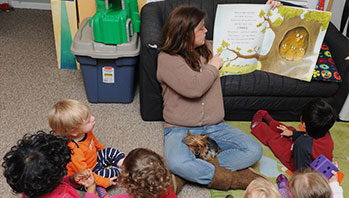- dirt
- root
- tunnel
- underground
- worm
MA Standards:
English Language Arts/Literature/RL.PK.MA.1: With prompting and support, ask and answer questions about a story or a poem read aloud.
English Language Arts/Literature/RL.PK.MA.4: With prompting and support, ask and answer questions about unfamiliar words in a story or poem read aloud.
English Language Arts/Literature/RL.PK.MA.10: Listen actively as an individual and as a member of a group to a variety of age-appropriate literature read aloud.
English Language Arts/Language/L.PK.MA.5: With guidance and support from adults, explore word relationships and nuances of word meanings.
Head Start Outcomes:
Literacy Knowledge/Book Appreciation and Knowledge: Asks and answers questions and makes comments about print materials.
PreK Learning Guidelines:
English Language Arts/Reading and Literature 6: Listen to a wide variety of age appropriate literature read aloud.
English Language Arts/Reading and Literature 10: Engage actively in read-aloud activities by asking questions, offering ideas, predicting or retelling important parts of a story or informational book.
Read Together: Wonderful Worms

© Commonwealth of Massachusetts, Department of Early Education and Care (Jennifer Waddell photographer). All rights reserved.
STEM Key Concepts: Plants get their needs met from the environment (their habitat); Some plant parts are below the ground and some above; Earthworms are animals that live in the soil, underground
ELA Focus Skills: Active Listening, Book Appreciation, Concepts of Print, Listening and Speaking, Story Comprehension, Genre, Vocabulary
Show children the cover of Wonderful Worms by Linda Glaser. Read aloud the title, pointing to each word. Tell children that this a book about real earthworms and how they live. Say, A book that tells facts about real things and events is called a nonfiction book.
Before You Read
Have children describe what they see on the front cover.
- Discuss what children know about worms. Ask, Do you think the book will tell us about how a worm helps the soil plants grow in?
- Set a reading focus for children by asking them to listen to all the ways worms work in the soil that plants grow in.
As You Read
Read slowly and with expression. Pause and talk about how the author describes worms and the underground.
Talk with children about how the illustrations can help them understand what worms do in the soil and how their work makes the soil easier for plants to grow in. For example,
- On the page where the author uses the words passageways and burrows. Ask, What do you think a passageway or burrow is? Do you think these passageways in the soil might be good for plants? Why?
- On the page where the author notes that worms make the soil soft and airy, say, Let’s look carefully. What do you suppose happens when worms make all of these tunnels? Do you think these tunnels in the soil will help plants? Point out that there are “openings for light and air and water.” Then explain that these openings help the plants get air and water that they need to grow.
Encourage children to raise their hand when notice other things worms do in the soil.
After You Read
Turn to the last page and reread the text. Ask children, Why do you think the author calls worms “underground gardeners”? You may need to flip through the pages so children can point out the different ways worms help prepare the soil that plants grow in.
Adaptation: If very young children have trouble concentrating during the whole book, read a part at a time. Discuss that part before moving on to the next.
English Language Learners: To help children grasp the concepts of aboveground and underground you may want to begin to develop the concepts of above and below or under. For example, place a book above the table, under the table; above the whiteboard, below or beneath the whiteboard, etc. After children have grasped this concept you may want to extend their understanding by taking them outside and showing them the difference between aboveground and underground. Have children point out the things above ground. Then dig a small hole in the ground and help children identify things that are underground.
